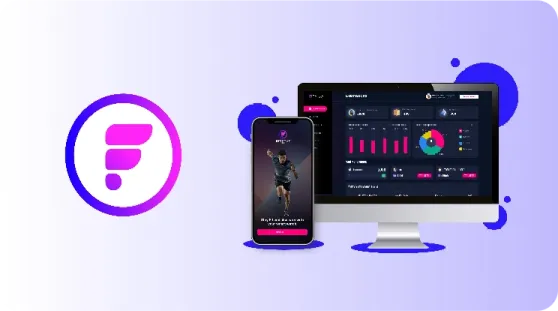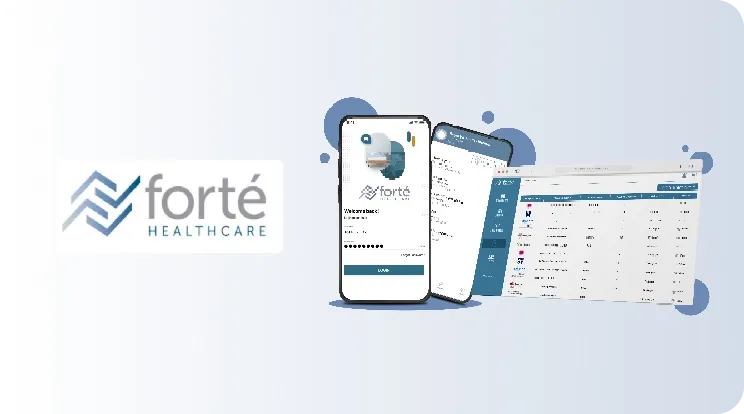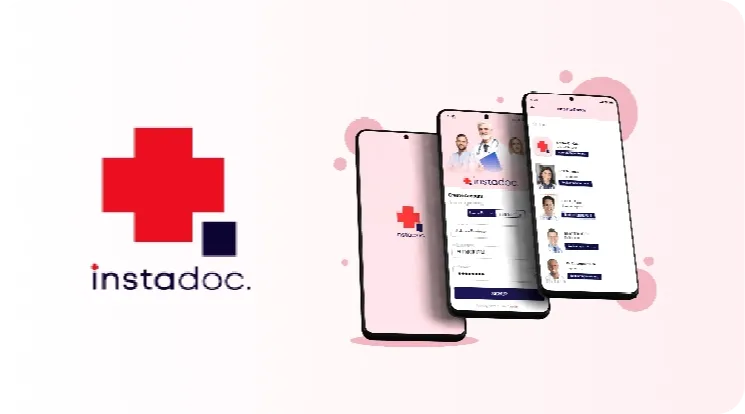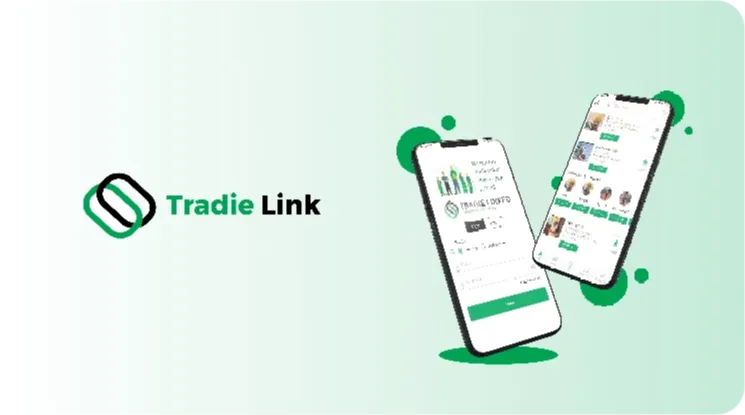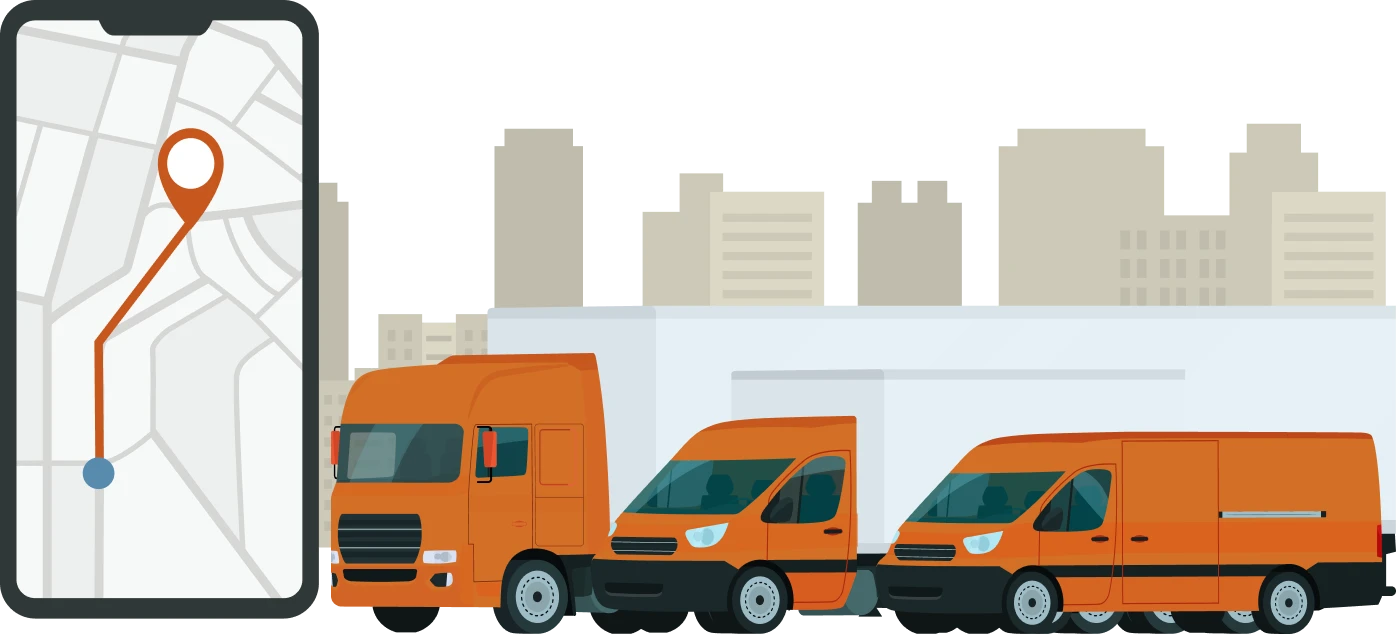
Revolutionize Your Fleet: Uses Cases and Trends of IoT in Fleet Management in 2025
Nov 13, 2024
In industries such as construction, agriculture, and transportation, fleet management is critical for daily operations and business success. Without proper fleet management and maintenance, costs can rise, and operations can suffer. Today, thanks to advancements in technology, particularly the Internet of Things (IoT), the fleet industry is transforming quickly. But how does IoT improve fleet management for businesses in 2025? This question is at the core of modern fleet solutions as companies increasingly rely on real-time tracking, vehicle monitoring systems, and predictive maintenance to streamline their operations.
With IoT technology, fleet managers can collect data from vehicles to track routes, save on fuel, and schedule maintenance before problems occur. By 2025, the IoT fleet management market is expected to exceed USD 15 billion, demonstrating IoT’s critical role in reshaping the industry. IoT applications, often custom-built with IoT app development companies, are helping fleet managers to keep up with these advancements. These apps make it easier to gather data, get alerts on vehicle health, and improve decision-making, all from a single interface.
By integrating IoT sensors and GPS tracking, fleet managers gain deeper insights into operational efficiency and asset health. This data-driven approach not only enhances decision-making but also reduces the total cost of ownership. In this article, we will cover IoT’s most impactful use cases in fleet management, the latest telematics trends, and how businesses can leverage these tools to improve fleet productivity and safety.
Understanding IoT in Fleet Management

IoT in fleet management involves the use of sensors and interconnected devices that continuously monitor and manage vehicles in real-time. These devices collect information on tracking vehicle location, fuel usage, maintenance status, and many more aspects in relation to driver behavior that fleets monitor in real-time. Indeed, one of the questions that immediately flicker into people’s minds is: “How does IoT help in fleet management?” IoT means tracking the locations of vehicles so that routes can be planned more effectively, and deliveries can be made on time. It also helps in tracking fuel consumption and highlights areas where drivers need to improve and become more efficient. Moreover, IoT provides predictive maintenance, which can provide complete protection against sudden failure as managers are informed about vehicle problems before they escalate into major ones. This has the consequence of less repairs and fewer operating costs. Additionally, IoT enables safety because it monitors driver behavior and ensures that the truck carries out its activities relative to safety standards. Therefore, it enhances fleet management by being effective, cost-effective, and also reliable.
IoT Mechanisms and Their Impact on Fleet Management Systems
IoT systems grasp the interconnected sensors. It also grasps software platforms and devices that are interconnected. It is for the transmission, collection and analysis of data. That also from vehicles and environments nearby. By integrating of solution of IoT into the management operations of the fleet, businesses obtain access to a wealth of information in actual time. It helps in the empowerment of enlightened decision-making. Thus, helping in the optimisation of the performance of the fleet.
Key Components of IoT Systems in Fleet Management
Telematics of Vehicles
Telematic devices are installed in vehicles. They help with the collection of data on location. Fuel consumption, speed, behaviour of the driver and diagnostics of the engine. These devices help in the transmission of data to centralised servers. It is used for interpretation and analysis.
Actuators and Sensors
Sensors that are enabled by IoT assist in the monitoring of certain parameters like humidity, temperature, pressure of the tyre and status of the cargo. Actuators help in enabling remote control for the functions of the vehicles. For instance, locking of the door and immobilisation of the engine.
Solutions of Connectivity
IoT systems rely on the communication of wireless technologies. For instance, Wi-fi, cellular networks, and satellite links. It is to the transmission of data between vehicles, servers of the backend and infrastructure.
Machine Learning and Analytics of Data
Algorithms of advanced analytics help in analysing of data of IoT. It is in identifying patterns, trends and anomalies. Machine learning models help in enabling the maintenance by prediction. It also enables analysis of the behaviour of the data and optimisation of the route.
IoT Applications in the Management of Fleet
GPS trackers that are enabled by IoT provide visibility in actual time. And, for the vehicle status in the fleet. Managers of the fleet can help in monitoring the movement of the vehicles. It also helps in tracking the utilisation of assets. They also help in efficiently optimising routing for operations.
Maintenance with Predictions
Sensors of IoT help in the collection of data on the health indicators of the vehicle. It is also referred to as a vehicle health monitoring system by some people. Data consists of oil quality, engine performance and brake wearing. Algorithms from the maintenance by prediction help in the analysis of data. The data helps in the identification of possible failures. That too before occurring. Thus, it helps in enabling dynamic scheduling of maintenance. It also decreases downtime.
Efficiency and Management of Fuel
IoT systems help in monitoring the patterns of consumption of fuel. It also monitors the behaviour of the drivers and idle times. It is to identify opportunities for reduction of emissions and savings of fuel. Alerts in real-time help in notifying fleet managers of refuelling in an unauthorised way, theft of fuel and inefficiency in practices of driving.
Compliance and Safety of the Drivers
Solutions of IoT help in tracking the behaviour metrics of the driver. Metrics such as harsh braking, speeding and unrestricted acceleration. Managers of the fleet can use this data to coach the drivers. It also enforces safety policies. It also ensures compliance with regulations. With regulations of hours of service. It also ensures inspection of the requirements of vehicles.
Logistics and Optimisation of Routes
Solutions of IoT help in tracking the behaviour metrics of the driver. Metrics such as harsh braking, speeding and unrestricted acceleration. Managers of the fleet can use this data to coach the drivers. It also enforces safety policies. It also ensures compliance with regulations. With regulations of hours of service. It also ensures inspection of the requirements of vehicles.
Security and Monitoring of Cargo
Sensors of IoT are equipped with the capabilities of geofencing. It is for monitoring the integrity of the cargo. It also detects tampering or access performed in an unauthorised manner. It sends alerts to the fleet managers if there is any possibility of a security threat. It also enables prompt intervention. It also measures the reduction of risks.
Future IoT Fleet Management Trends Everyone Should Know

Telematics
The combination of informatics and telematics is not new in development. But it has become common nowadays. That too immensely. Even people who own private cars opt to use modern-day trackers more frequently. They also opt for telematic apps that are compatible. They are compatible with receiving the benefits of insurance. Benefits of practising safe driving.
Commercial vehicles are not only advantageous with the rewards of insurance. But they also utilise the technology of telematics. It is to monitor the behaviour of the driver. It can also make interventions if there is any necessity for the safety and well-being of the driver. Telematics is expected to be much more advanced in the future. It has become more extensive than it is at present.
Driving Independently
Driving independently is not as extensive as any other technology. But it is expected to be a major trend in the future. It aims to make improvements in road safety. It improves by decreasing the number of accidents that are caused due to mistakes caused by humans. With self-driven cars, there is no requirement for the human driver for each of such vehicles. It is making logistics and transportation more dependable and efficient.
EVs
In the automotive industry, cars with combustion engines are becoming obsolete gradually. With more and better dependable technology. Electric vehicle (EV) production is elevating constantly. Its corresponding infrastructure will also increase in a constant mode. To remain competitive and decrease footprints of carbon, businesses must upgrade their fleet of vehicles. They can be replaced with EVs as early as possible.
Software for Fleet Management
With the use of software solutions like fleet management or Fleet monitoring software, businesses can improve efficiency at work. They can also decrease the running costs.
Advantages of Using IoT in the Management of Fleet
Some challenges faced by the operators of the fleets are also involved in these advantages. The advantages that are offered by solutions of IoT fleet management. The following are some of the important advantages that an enterprise can gain by utilising solutions for IoT fleet management.

Thorough Analysis
Sensors of IoT can gather huge amounts of information. It includes downtime, usage, fuel usage and location and health of the vehicle. Businesses check the data in clean statistics and analysis. It allows them to gain an intense understanding of their vehicles and assets. With the help of this knowledge, they can make well-informed decisions. It is regarding maintenance, safety and utilisation.
More Flexibility
Fleet management software that is cloud-based can offer more flexibility. Especially when it comes to models of modern and advanced works. Information can be retrieved by the employees. They can retrieve it from anywhere and anytime. Especially if internet connectivity is available. It thus makes remote tasks easy for the operators and managers of the fleet. Drivers can also retrieve crucial information on-route. It allows them to stay updated on all necessary matters.
Improved Tracking of Vehicles
One of the main advantages of IoT in the management of fleets is improved tracking capabilities of vehicles. GPS tracking systems enabled by IoT allow fleet managers to monitor the exact location. As well as the vehicles’ movement in actual time. This visibility efficiently helps in the planning of the route. It also enables enhanced dispatching and response to the inquiries of the customers on time. Moreover, it helps in the prevention of the use of unauthorised vehicles, misuse and theft. It further enhances the protection of the assets and security.
Tracking in real-time also facilitates dynamic decision-making. Which is in unforeseen events. Such as accidents, congestion to traffic, unfavourable conditions of the weather or accidents. By grasping data of IoT, managers of the fleet can adversely vehicle rerouting, adjustment of routes and optimising schedules of delivery. It is for decreasing delays. It also ensures arrivals on the actual time.
Furthermore, tracking systems enabled by IoT provide historical analytics and data. It enables analysis of performance. Identifying the trends and optimising utilisation of the fleet. By analysing data on historical routes and patterns of traffic, managers of fleets analyse inefficiencies, decreased consumption of fuel and optimisation of routes. Thus, it leads to important savings in cost and advantages of the environment.
Prophetical Maintenance
Another important advantage of IoT in the management of fleets is its predictive or prophetical maintenance. Sensors that are enabled by IoT and devices of telematics monitor the health of vehicles. It also monitors real-time parameter performance. It enables detection at an early stage. It detects the possibility of issues. And the intervention of maintenance proactively. Data analysis on the diagnostic of the engine, consumption of fuel, wearing of the tyre, and other evaluative components that can be identified by the managers of the fleet. It can identify issues appearing before escalation. Escalation of expensive breakdowns or safety risks.
Managers of the fleet are enabled by the maintenance of predictions. It is for the optimisation of the inventory of spare parts. They also optimise streamlining of maintenance of workflows, and allocation of resources. That is also more effective. Making focus on the resources of the vehicles requires attention instantly. Companies can give priority to maintenance activities. It decreases disruptions in ongoing operations.
Optimisation in Efficiency of Fuel
Fuel denotes an important cost of operations for the operators of the fleet. It thus makes it a high priority to optimisation of efficiency of fuel. The technology of IoT plays an important role in the optimisation of the efficiency of fuel. It is by providing insights in actual time. Insights of actual time into the performance of the vehicles, consumption patterns of the fuel, and behaviour of the driver. Onboard sensors and telematics devices help in parameter monitoring like acceleration, speed, idling of the engine and efficiency of the route. It enables managers of the fleet to identify opportunities. It is for savings of the fuel and decrease of the emissions.
By analysing data on the consumption of fuel and the behaviour of the driver, managers of the fleet can identify inefficiencies. Implementing the right measures and qualified drivers for adopting more driving habits for efficiency of fuel. Solutions of IoT also help in enabling strategies of fuel management implementation. Such as optimisation of routes, maintenance of vehicles, and purchasing decisions for fuel. Decisions are based on market prices on actual time.
Furthermore, facilitation of fuel card data integration, telematics of vehicles and transaction of fuel pump. All of these are into a centralised platform. It also provides complete visibility. Along with that control over usage and expenses of fuel. By monitoring trends in fuel consumption, detecting anomalies and enforcing efficiency of policies of fuel. Businesses can decrease the cost of fuel and impact the environment. Hence in achieving worthwhile goals.
Safety of the Drivers
Ensuring the safety of the drivers is supreme in the operations of fleet management. The technology of IoT helps in enabling analysis and monitoring of the behaviour of the driver in actual time. It also enables managers of the fleet to identify unsafe practices. It reduces risks and promotes safe driving habits. Devices that are telematic help in capturing data on the speed of the driver, braking, accelerations and obedience to traffic regulations. Thus, providing insights that are valuable into the behaviour and performance of the driver.
By analysing data of the driver and implementations of safety initiatives such as training programs for the drivers, coaching sessions and schemes of incentive. Businesses can decrease accidental risks, claims of liability and injuries. Moreover, the monitoring system of the drivers enabled by IoT can also detect distraction, fatigue and other factors of impairment. It allows managers of the fleet to intervene. It prevents possible accidents before occurrence.
Additionally, to improve the safety of the drivers, the technology of IoT improves the capabilities of emergency responses. It is done by providing alerts in actual time. It also sends notifications during accidental events. They also send during breakdowns or if there are any other emergencies or mishaps. Managers of the vehicle can track the location, condition and status of the vehicles from a distance. It enables dispatch of personnel support, services in emergencies and roadside assistance on time.
Improvement in Customer Service
In the industry of competitive transportation, satisfaction to customers is an important differentiator. The technology of IoT helps in enabling businesses to deliver customer service of superior quality. It is done by providing communication, visibility and transparency in actual time. It is throughout the entire process of delivery. Tracking of the GPS helps customers track the location and status of their shipments in real-time. It does provide assurance and peace of mind. That also regards timeline delivery and exact order. Thus, IoT helps in seamless shipment monitoring.
Furthermore, fleet management platforms enabled by IoT help in enabling proactive mechanisms of communication and notification. It allows companies to keep customers attached to the status of the orders, unforeseen problems and delays. By providing resolution of inquiries to customers and updates on time, businesses can improve loyalty, trust and levels of satisfaction. Thus, leading to business repetition and positive referrals of word-of-mouth.
Moreover, the technology of IoT helps enable businesses to capture and analyse feedback from customers. And also analyse their metrics of satisfaction and preferences. Thus, allowing continuous enhancement of quality of service. Plus, performance of delivery. By grasping insights that are driven by data companies can determine areas for improvement. They can also determine the addressing of pain points of the customers and improve their experience.
Reduction of Cost
Reduction of cost is an important objective of the operators of a felt. The operators who seek improvement in profitability and competitiveness. The technology of IoT offers innumerable opportunities. In reducing cost across various aspects of the fleet’s management operations. By optimising the utilisation of vehicles, consumption of fuel and efficiency of routes, companies can help achieve important savings. That too in expenses that are operational and resource utilisation.
Maintenance with predictions helps enable businesses to decrease downtime that was uncalled for. And, to decrease the deprecation of vehicles and cost of repairment. It thus results in improved utilisation of assets and management of the lifecycle. By making identifications in the issue of maintenance in the early stage. And, by making them address proactively. Businesses can also decrease expensive breakdown risks. Thus, they enable to enlarge the life of the vehicles.
The technology of IoT helps in enabling companies to optimise the allocation of resources. Enhance productivity and streamline workflows. Manual task automation, decreasing processes that are redundant and grasping insights that are driven by data. By implementing these businesses can achieve higher efficiency in operations. And, in the optimisation of resources. It thus leads to savings in cost. And improvement in profitability.
Moreover, the dynamic pricing model’s implementation is facilitated by IoT. They also facilitate forecasting of demands and strategies of inventory management. It also enables businesses to increase profitability and revenue. It is while decreasing inventory stockouts and cost for carrying.
Common Use Cases of IoT Fleet Management
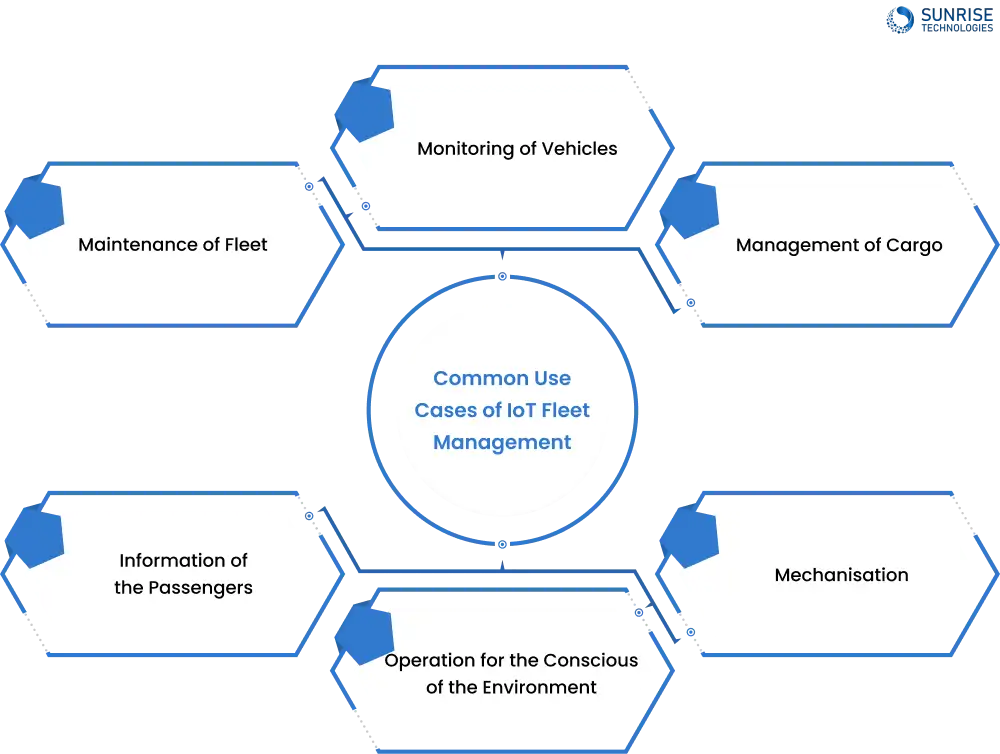
Maintenance of Fleet
Analysis of data, Algorithms made with predictions and telematics infusion. They are all useful. Especially when it comes to primary issues in any vehicle. It also helps in the prevention of motor damage, batteries, brakes and tyres. Thus, it makes vehicles long-lasting and efficient.
Monitoring of Vehicles
Optimisation of algorithms, sensors and cameras helps in the analysis of data. They ensure the protection of vehicles. Fleets that are equipped with sensors give updates on time. They also give alerts as warnings if any parts have the requirement of checkup. Or they are close to being unsuccessful. Alerts like scheduled maintenance, battery life, and coolant temperature pressure of tyres. All these aspects help with the smooth running of vehicles.
Management of Cargo
Enhanced technologies like telematics with sensors, monitoring of temperature and surveillance play an important role in today’s logistics and supply chain. A check on different parameters of the environment. It helps in keeping those items safe that are perishable. Cameras and other sensors also help ensure the welfare and protection of the cargo.
Information of the Passengers
Buses and other passenger vehicles that are enabled by IoT help in providing information. Information on routes, services and fares. It helps in informing passengers about regulations and rules. It is while providing services like Wi-fi and paperless ticketing. Video surveillance can be accessible by the operators of the bus. It is to gather data about defaulters, passengers and other protocols.
Operation for the Conscious of the Environment
Using the technology of IoT, managers can track the behaviour of the drivers and get updates on actual time. It can help to reduce issue-related behaviours like over-speeding, wastage of fuel, and rash driving. Inactive vehicles are the actual emitters of carbon. IoT can help businesses to cut down on these practices. It is for saving your capital. And be friendly to the environment.
Mechanisation
If you are thinking to mechanise the management of your fleet, IoT will help in flawlessly mechanizing various processes. It also helps with the flawless mechanization of your trip planning. Whether it is a selection of fast routes breakdown of vehicles or sending messages to be warnings or alerts, IoT can help you to make your management fleet aware. That too makes it less interesting for humans.
Real-Life Use Cases of IoT in Fleet Management
They are providers of solutions for data analytics and SaaS fleet management. They are said to be the discoverers of Transportation technology. For inconsiderate driving, they have released SmartSense. Integration of SmartSense, AI for inattentive driving or inattentiveness in general. Along with a camera that faces the cab. SmartSense also has computer vision for detection of drowsiness, usage of cell phones, smoking and inattention. It also sends alerts to the drivers to take necessary action to avoid collision.
They partnered with Intel to create a solution based on vision. It is for the safety of the assets and operations of the vehicles. Built-in sensors and 360-degree cameras help in the high-resolution streaming of vehicles. It helps to prevent theft and collision by automatically identifying unusual activity around the vehicle.
It is a French company that was formed in 2019. It was formed as a joint venture between Sigfox, Argon and Michelin. It was launched as a system for tracking assets. The launch was made with the help of Azure IoT fleet management. Trackers are on assets. And connected to the network of Sigfox OG. With its help managers can track the exact location of pallets, trailers or industrial tools of geolocation. That too in actual time.
To be competitive in the transportation and logistics industry, businesses have to adopt modern solutions like IoT for fleet management. IoT encompasses challenges including safety, maintenance, fuel management, and asset usage. One question many businesses have is, how does IoT help in managing fleet operations? Businesses can know vehicle performance, predict maintenance requirements, and optimize fuel usage with help from IoT applications such as Fylde by Sunrise Technologies. These solutions save money because it minimizes machine downtime and increases productivity rate.
IoT helps in real-time data collection; it increases the level of safety through driver behavior monitoring and adherence to legal regulation. With IoT, companies can make their fleet more efficient and avoid costly repairs. If you’re looking for IoT app development services, we are a leading software development company, can provide custom solutions tailored to your unique needs. The adoption of the IoT technology marks a huge leap for logistics companies.
Sam is a chartered professional engineer with over 15 years of extensive experience in the software technology space. Over the years, Sam has held the position of Chief Technology Consultant for tech companies both in Australia and abroad before establishing his own software consulting firm in Sydney, Australia. In his current role, he manages a large team of developers and engineers across Australia and internationally, dedicated to delivering the best in software technology.












